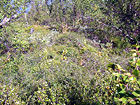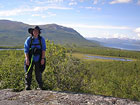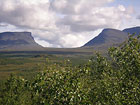

 | |||||||||||||||||
|
|
Journals 2005/2006J. Rebecca Gould Calabro
August 3, 2005 Here I am at the Abisko Scientific Research Station at latitude 68(20'. Boston, to compare, rests at a latitude of 45°32'. We are landlocked, about an hour and a half from the Norwegian Sea and the biome that surrounds is called an "ecotone." This simply means that this sub Arctic area includes alpine tundra and boreal taiga.
The first day introduced us to the three types of Arctic biomes. A biome is simply a regional ecosystem characterized by distinct types of vegetation, animals, and microbes that have developed under specific soil and climatic conditions. Boston is a temperate forest. This means that temperatures do not become extremely hot or extremely cold. One obvious difference was that in Boston we have trees greater than 60 feet tall. Here in the sub Arctic the trees were very skinny and not much more than 20 feet tall. The only tree that resembled the North American pine tree was a stump that had been found in Lake Tornetrask that had been dated to at thousands of years ago. Our day one lecture with Henrik Lange had begun. The subject of this lecture was to give us an overview of the Arctic biome and the ecology we would encounter. In my journal, I have highlighted interesting facts that pertain to various aspects of the Boston Science curriculum. There are three Arctic biomes. The one that most people think of when they speak of the Arctic is the Sea Ice biome. This is actually a home for many species including the polar bear. Seals, birds, and various people also make their home on this floating sea ice. Another biome is the tundra. This is characterized by extremely cold climates. The average winter temperature can often get to -34 degrees Celsius (that's -30 degrees Fahrenheit). To give some perspective, our winter temperature rarely gets below 0 degrees Fahrenheit! The tundra is also characterized by an ecosystem with a very short growth and reproduction season. In fact, the only reason that there is any life at all up here in the sub Arctic and Arctic is that the average summer temperature can range from 3 to 12 degrees Celsius (that's 37 to 54 degrees Fahrenheit). Unlike the Boston ecosystems where life is teeming at every corner, there is very limited biotic (living) diversity here in the sub Arctic and Arctic environments. Lastly, the third Arctic biome is that of the taiga or the boreal forest. This is the largest terrestrial forest on earth and it lies between 50 degrees and 60 degrees. The Arctic Circle lies at 66 degrees and roughly defines where temperate forests as we are familiar with in Boston terminate. So I am really in the taiga now. The growing season of places above this Arctic Circle lasts for 150 days -- that's less than half a year! 2/3 of the Earth's taiga lies in Siberia. The rest can be found in Scandinavia, Alaska and in Canada. Up here in the far north yields very short summers -- there will only be between 50 and 100 frost-free days all year! This is despite that fact that during the summer, the sun does not set until at least 11PM (if it sets at all). |
||||||||||||||||


